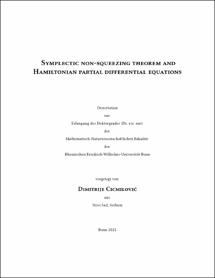Cicmilović, Dimitrije: Symplectic non-squeezing theorem and Hamiltonian partial differential equations. - Bonn, 2021. - Dissertation, Rheinische Friedrich-Wilhelms-Universität Bonn.
Online-Ausgabe in bonndoc: https://nbn-resolving.org/urn:nbn:de:hbz:5-64671
Online-Ausgabe in bonndoc: https://nbn-resolving.org/urn:nbn:de:hbz:5-64671
@phdthesis{handle:20.500.11811/9440,
urn: https://nbn-resolving.org/urn:nbn:de:hbz:5-64671,
author = {{Dimitrije Cicmilović}},
title = {Symplectic non-squeezing theorem and Hamiltonian partial differential equations},
school = {Rheinische Friedrich-Wilhelms-Universität Bonn},
year = 2021,
month = dec,
note = {The thesis is concerned with providing a first natural generalization of M. Gromov's non-squeezing symplectic result in infinite dimensional case and applying it within the context of Hamiltonian partial differential equations.
First part of the thesis covers a special case of the infinite dimensional generalization, adapting the approach suggested by A. Sukhov and A. Tumanov for the treatment of the finite dimensional case. We contend that this is an important generalization of Gromov's result and contribution to an open question whether the generalization holds in full generality in infinite dimensional case.
Second part covers an application of the aforementioned result to Hamiltonian equations. Namely, we recover known non-squeezing results for mass subcritical and critical nonlinear Schrödinger equation by R. Killip, M. Visan, X. Zhang and for Korteweg–De Vries equation by J. Colliander, M. Keel, G. Staffilani, H. Takaoka, T. Tao. The first result for complex modified Korteweg–De Vries is obtained. All previous results relied heavily on well-posedness theory at symplectic regularity. We follow the same principle, however, first part of the thesis significantly simplifies proofs of known results. This is due to the fact that all previous approaches were based on reduction of initial equations of interest to the finite dimensional Hamiltonian flow, for which one would recall Gromov's result. Whilst the choice of the reduction to the finite dimensional case was usually an obvious one, infinite dimensional formulation is natural and more flexible as approximations are needed regardless of the equation.},
url = {https://hdl.handle.net/20.500.11811/9440}
}
urn: https://nbn-resolving.org/urn:nbn:de:hbz:5-64671,
author = {{Dimitrije Cicmilović}},
title = {Symplectic non-squeezing theorem and Hamiltonian partial differential equations},
school = {Rheinische Friedrich-Wilhelms-Universität Bonn},
year = 2021,
month = dec,
note = {The thesis is concerned with providing a first natural generalization of M. Gromov's non-squeezing symplectic result in infinite dimensional case and applying it within the context of Hamiltonian partial differential equations.
First part of the thesis covers a special case of the infinite dimensional generalization, adapting the approach suggested by A. Sukhov and A. Tumanov for the treatment of the finite dimensional case. We contend that this is an important generalization of Gromov's result and contribution to an open question whether the generalization holds in full generality in infinite dimensional case.
Second part covers an application of the aforementioned result to Hamiltonian equations. Namely, we recover known non-squeezing results for mass subcritical and critical nonlinear Schrödinger equation by R. Killip, M. Visan, X. Zhang and for Korteweg–De Vries equation by J. Colliander, M. Keel, G. Staffilani, H. Takaoka, T. Tao. The first result for complex modified Korteweg–De Vries is obtained. All previous results relied heavily on well-posedness theory at symplectic regularity. We follow the same principle, however, first part of the thesis significantly simplifies proofs of known results. This is due to the fact that all previous approaches were based on reduction of initial equations of interest to the finite dimensional Hamiltonian flow, for which one would recall Gromov's result. Whilst the choice of the reduction to the finite dimensional case was usually an obvious one, infinite dimensional formulation is natural and more flexible as approximations are needed regardless of the equation.},
url = {https://hdl.handle.net/20.500.11811/9440}
}






